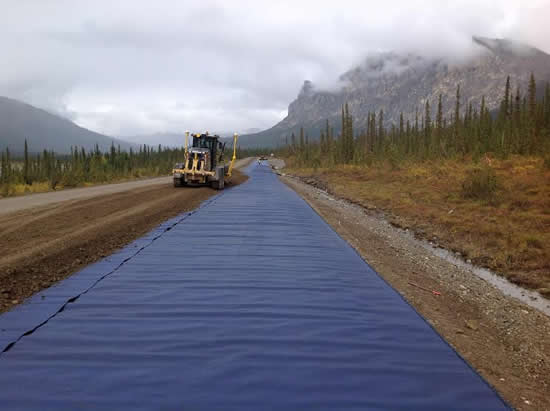A woven geosynthetic was installed on the Dalton Highway in northern Alaska. The work was part of a research project being conducted by the University of Alaska-Fairbanks. The heavily instrumented test section, which sought to reduce frost heave and boils, was installed on a stretch of highway called Beaver Slide.
Beaver Slide was a well-known problem spot for the Alaska DOT. It required constant repairs during spring thaw due to frost heaves and frost boils in the roadway. The hope was that the utilization of this woven material (Mirafi® H2Ri) could remove water from the difficult section of roadway. If it could, it would eliminate the water’s ability to form ice lenses. The formation of those lenses was the main cause of the frost heave.
The Beaver Slide section has been monitored by sensors to track moisture content in the section. The area has also been visually monitored to track roadway damage.
In the 6 years since the installation, the test section has been a tremendous success.
Moisture monitors have shown that water entering the roadway section is quickly removed through the geosynthetic, thus eliminating the ability for ice lenses to form.
RELATED: High-Strength Wicking Geotextile Stabilizes Detention Pond
More importantly, this section of road which has required yearly repairs has not experienced any issues or complications. In fact, the highway leading up to and following the test section continues to experience issues due to frost heave and frost boil formation, but the section where the Mirafi® H2Ri is installed is still in great shape and performing as expected.
Te feature image atop this article demonstrates the materials dramatic wicking effect. The view of the installation faces north. The impact of the geosynthetic on the surrounding moisture is clear.
WATER IN THE ROAD
The influence of water is well known for the destruction it causes in a roadway. Although many geosynthetics have been able to provide separation and/or reinforcement to roadways, the integration of water removal through wicking have not been previously combined. With a wicking component, the water is removed during saturated and unsaturated conditions.
Mirafi® H2Ri was developed by TenCate Geosynthetics to combine the ability to provide separation, reinforcement and active drainage. Frost heave and frost boils are one such application. The Beaver Slide project stands as a strong testament.

MITIGATING FROST HEAVE
The Dalton Highway has been an ideal spot to test this geosynthetic approach. The highway is one of the most isolated roads in the United States, but it serves a large amount of truck traffic. It is the only route for ground transportation between the oil fields at Prudhoe Bay and the city of Fairbanks. The extreme northern environment causes degradation of this 500-mile highway due to frost heave.
Beaver Slide is located at Mile 110. There, the roadway has historically experienced severe deterioration during spring thaws due to shallow groundwater, which runs downslope on an 11% grade under the highway.
These conditions caused water to pool in the road embankment, and that build up led to the highway-damaging frost boils.
The Alaska DOT – University of Alaska-Fairbanks project confirmed, through excavation, that an organic tundra layer was 4 – 5 feet below the road surface. Frozen soil was also encountered along with water from the high ground water table.
Two layers of the Mirafi® H2Ri were installed 18 in. apart with the first layer installed directly on the subgrade. Sensors were placed below and above the first geosynthetic layer. Additional sensors were placed atop the second geosynthetic layer. Sensor leads were bundled and buried in a trench that led to a data collection unit on the side of the road.

In total, 22 sensors, placed in a grid-like pattern, were used to measure moisture levels and temperature changes throughout the roadway cross section.
More than five years later, that data is yielding exceptional proof of the validity of this geosynthetic approach to countering frost heave and boils in northern roads.
**
For more information on TenCate’s geosynthetic materials and project expertise, and for more information on Mirafi® H2 Ri woven geosynthetics, visit www.tencategeo.us.











